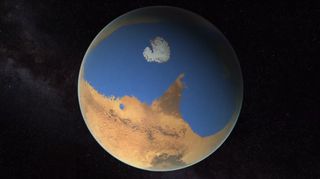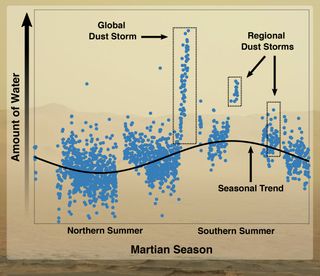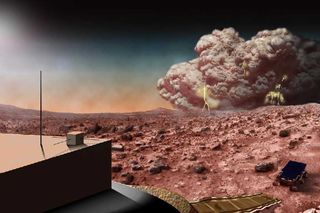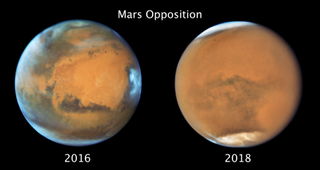Big dust storms may have driven off much of Mars' water
Dust storms and summer heat may have removed an ocean's worth of water from Mars.

Martian dust storms fling water higher into the atmosphere than previously thought possible, helping to strip the Red Planet of its limited water and potentially contributing to the loss of an ocean's worth of water over billions of years, a new study finds.
The research reveals that summer dust storms can send water to the top of Mars' atmosphere, destroying the molecule and allowing hydrogen to escape into space.
Mars is thought to have supported an ocean or two in its early days. But the water that could have once kept the planet's surface habitable was lost over the eons, and scientists have been searching for the cause. Now, researchers using NASA's Mars Atmosphere and Volatile EvolutioN spacecraft, or MAVEN, have learned that powerful summer dust storms may carry water above the hygropause, a cold layer in the atmosphere that traps water lower down.
Water on Mars: Exploration and evidence

"Dust storms inject a sudden splash of water into the upper atmosphere," study lead author Shane Stone, a graduate student at the University of Arizona, told Space.com by email.
Stone worked with his colleagues to use data collected by MAVEN on its deep dives into the atmosphere over more than two Martian years (a little less than four Earth years). They found that the abundance of water peaked during the southern summer, when the planet is closest to the sun and global dust storms are more common. The results were published on Nov. 13 in the journal Science.
"During a global dust storm, the new process we describe produces [hydrogen] atoms at a rate that is 10 times that of the classical process," Stone said.
Get the Space.com Newsletter
Breaking space news, the latest updates on rocket launches, skywatching events and more!
'A sudden splash of water'
On Earth, the hygropause serves as a barrier to trap water in the lower atmosphere. When water vapor reaches the colder patch of sky, it condenses from gas to liquid to form clouds. Once the water condenses, it stops traveling upward.
While previous studies have suggested that water could be transported above the Martian hygropause, the new research found a seasonal trend, as well as a link to dust storms, in the amount of water found in the upper atmosphere. In contrast, the previous models of how the Red Planet's water is lost allow for a slow seepage of water from the middle atmosphere through the hygropause and into space.
"The classical process is like a slow and steady trickle of hydrogen into the upper atmosphere which varies little from Martian year to Martian year, while the process we describe is like a sudden splash of water into the upper atmosphere," Stone said.
While dust storms block light and heat from reaching the surface of the planet, they warm the hygropause, weakening it and allowing more water to pass through. The warmer temperatures of the southern summer also heat up the atmosphere, making the hygropause more porous.

When water molecules reach the upper atmosphere, they react with charged particles, or ions, and split into hydrogen and oxygen atoms. Because hydrogen is the lightest atom, some of the hydrogen atoms can reach speeds high enough to escape the pull of Mars' gravity and are stripped off into space.
"Once water reaches the upper atmosphere, it has a lifetime of about four hours," Stone said.
MAVEN's Neutral Gas and Ion Mass Spectrometer (NGIMS) instrument samples air when the probe dips into the Martian atmosphere to an altitude of 78 miles (125 kilometers), which happens every 4.5 hours. NGIMS doesn't directly measure water, because hydrogen and oxygen in the atmosphere can combine inside the instrument to create the molecule. Instead, NGIMS relies on ions, which it separates by mass so that researchers can identify them and calculate the amount of water in the upper atmosphere.
Under the classical model, most of the water in the middle atmosphere that is broken apart by sunlight falls back toward the surface. Only some of the new hydrogen molecules slip past the hygropause and into the upper atmosphere, eventually leaving the planet.
Long window for life on Mars: Hundreds of millions of years?
"This process is slow and steady from Martian year to Martian year, so scientists have known for five to six years now that the classical model could not possibly be responsible for rapid variations in the [hydrogen] escape, which have been observed to occur on timescales less than a Martian year," Stone said.

The newly inferred rapid release of water during the southern summer and during dust storms does not overturn the classical process, which continues to operate today. However, global and local dust storms flinging water into the upper atmosphere produces hydrogen atoms roughly 10 times faster than the classical process, Stone said. During most of the Martian year, the two processes liberate roughly the same amount of hydrogen atoms that can escape into space, he added.
Perhaps the most striking example of the rapid process in action was the 2018 global dust storm that put NASA's Opportunity rover out of commission. Measurements taken during two days of the storm noted 20 times more water released than via the classical process. Stone and his colleagues estimated that the monster dust storm caused Mars to lose as much water in 45 days as it typically loses during one Martian year, which is 687 Earth days long.
Regional dust storms, which occur every Mars year, lead to a smaller but still significant increase in the abundance of water in the upper atmosphere and the resulting loss of hydrogen, Stone said.

The researchers estimated that the seasonal process, without taking dust storms into account, would strip Mars of a 17.3-inch-deep (44 centimeters) global layer of water over the course of a billion years. Assuming a global dust storm like the 2018 event occurred once every decade, an additional 6.7-inch (17 cm) depth of global water would be lost in that time, with local dust storms each year contributing even more destruction.
The loss of the Red Planet's water slowly changed its atmosphere. Such changes can be difficult to model because a small shift can be magnified over the 4.5-billion-year life of the solar system. But Stone and his colleagues are confident that the seasonal shifts and dust storms played an important role in removing the water.
"The seasonal and dust storm-mediated delivery of water to the upper atmosphere could have played a substantial role in the evolution of the Martian climate from its warm and wet state billions of years ago to the cold and dry planet we observe today," the authors wrote in the new study. "Mars has likely lost enough [water] to cover the planet's surface with an ocean tens to hundreds of meters deep, and loss rates must have been higher in the past."
Follow Nola on Facebook and on Twitter at @NolaTRedd. Follow us on Twitter @Spacedotcom and on Facebook.
Join our Space Forums to keep talking space on the latest missions, night sky and more! And if you have a news tip, correction or comment, let us know at: community@space.com.

Nola Taylor Tillman is a contributing writer for Space.com. She loves all things space and astronomy-related, and enjoys the opportunity to learn more. She has a Bachelor’s degree in English and Astrophysics from Agnes Scott college and served as an intern at Sky & Telescope magazine. In her free time, she homeschools her four children. Follow her on Twitter at @NolaTRedd
